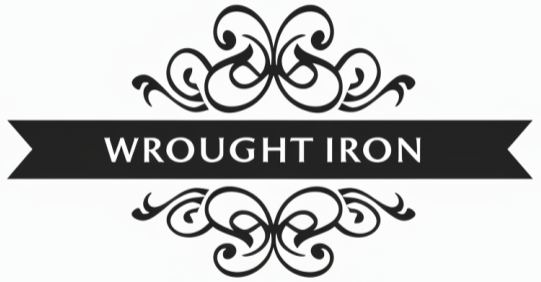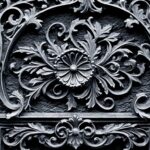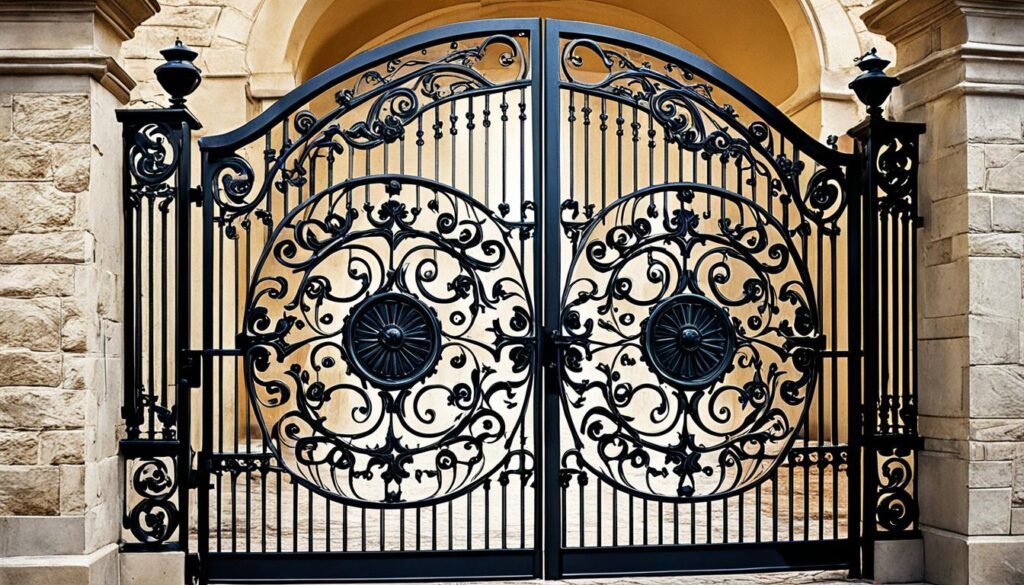
Have you ever looked at an old wrought iron gate and been amazed by its beauty? These gates tell stories of blacksmiths who worked hard to make them. They show us the beauty of ironwork, connecting us to history and guiding us forward. But many people confuse wrought iron with “rod iron.” Why does this matter? It’s because knowing the difference helps us see the art in each piece and make better choices for our projects.
Wrought iron is loved for being easy to shape and bend. It’s not as hard as cast iron and is often used in historic buildings. It has less carbon than cast iron, making it strong yet flexible1. Wrought iron also has special slag inclusions that add to its strength and beauty2.
For those working with metal, knowing these facts is key. It’s not just about technical terms—it’s about keeping a tradition alive and making new things with care. So, let’s explore the truth behind “rod iron” and “wrought iron.” Join us to see which one is in your garden gates and making history.
Key Takeaways
- The terms “rod iron” and “wrought iron” are often used wrong.
- Wrought iron is known for being easy to shape and having low carbon content.
- It has special slag inclusions that make it stronger than cast iron.
- Blacksmithing has kept wrought iron popular for its unique qualities.
- Knowing these differences helps in making better choices in metal work.
Understanding Wrought Iron: Characteristics and History
Wrought iron is a key material in metalworking, known for its unique traits and historical significance.
What is Wrought Iron?
Wrought iron is an iron alloy with very low carbon content. This makes it tough, malleable, and resistant to rust3. Its low carbon content sets it apart from other iron alloys3. It has a grainy texture from siliceous impurities, making it strong and easy to weld3. These qualities make it a top choice for many metalworking applications.
Historical Significance of Wrought Iron
Wrought iron started replacing bronze in Asia Minor around the 2nd millennium BC4. By the 3rd century BC, it was used for tools and weapons in China, India, and the Mediterranean4. In the 19th century, it reached its peak, being perfect for building construction and horizontal beams4. Today, it’s mainly used for decoration, seen in famous places like the Eiffel Tower and Buckingham Palace gates3.
Wrought Iron Production Methods
To make wrought iron, iron ore was heated with charcoal in a bloomery, creating a spongy mass called a bloom3. This method produced various forms like bar iron, rod iron, and hoop iron3. In the 15th–16th century, church screens showcased its beauty4. Even with new technologies, wrought iron is still prized for its looks and versatility in modern designs.
Rod Iron vs. Wrought Iron: Clearing Up the Confusion
Many people get confused between rod iron and wrought iron. They often use “rod iron” when they mean “wrought iron”. This mix-up comes from not understanding what wrought means. It means to work, so wrought iron is literally iron that has been worked by hand.
Common Misconceptions
Many think all old or decorative iron is wrought iron. But most “wrought iron” today is actually mild steel that looks like the real thing5. Real wrought iron is rare now because it was hard to make6.
Why the Confusion Exists
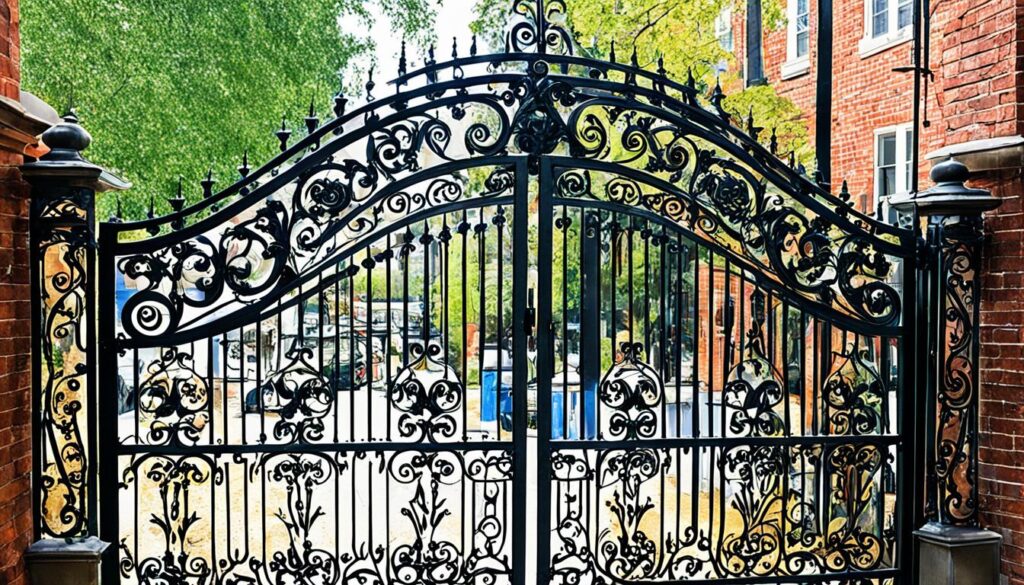
Many products called wrought iron are really mild steel, like fences and gates7. This has led to the wrong name being used a lot. Also, talking about what people want in wrought iron can be tricky5.
Correct Terminology
It’s important to use the right terms when talking about wrought iron. True wrought iron is made by hand and has unique designs7. It’s strong, doesn’t rust easily, and can be coated with zinc for extra protection6. On the other hand, mild steel iron is easier and cheaper to make, perfect for big projects7.
| Characteristic | Wrought Iron | Ornamental Iron (Mild Steel) |
|---|---|---|
| Production Method | Hand-forged, labor-intensive5 | Machine-shaped, mass-produced7 |
| Corrosion Resistance | Natural resistance, thicker zinc coating6 | Moderate resistance |
| Cost | Nearly twice as much as steel6 | Less expensive, suitable for large jobs7 |
| Usage | Historical marine applications, bridges, sculptors6 | Fences, gates, handrails, balconies7 |
Properties and Uses of Wrought Iron
Wrought iron has special properties because of its chemical makeup and how it’s made. We’ll look into its chemical composition, uses in metalworking, and benefits in ornamental ironwork.
Chemical Composition
Wrought iron has very little carbon, less than .035%. This makes it very malleable and tough8. It also has silicate slag inclusions that help it resist corrosion and give it a unique look when etched or bent8. These features make wrought iron strong against wear and tear, but it can still face corrosion issues like pitting and stress corrosion cracking8.
Applications in Metalworking
In architectural metalwork, wrought iron is key because it can be shaped easily. From the 1600s to 1700s, it was used a lot in building decorations like fences, gates, railings, and lamps8. But by the late 1800s, steel took over for most building needs because it was cheaper and lighter89.
Advantages in Ornamental Ironwork
Wrought iron looks great in ornamental ironwork. Its unique grain pattern when etched makes each piece special. This look, along with its strength and resistance to damage, makes it a top choice for decorative metalwork8. It can handle heavy loads and heat well, making it perfect for adding beauty and function to designs8.
Is It Rod Iron or Wrought Iron?
Knowing the difference between wrought iron and rod iron is key to understanding ironmongery and metal work. “Rod iron” is often wrongly used to mean wrought iron fencing, which is the correct term10. Wrought iron is an iron alloy with little carbon, making it soft and easy to shape into beautiful designs11. This makes it great for making fancy gates, fences, and decorations.
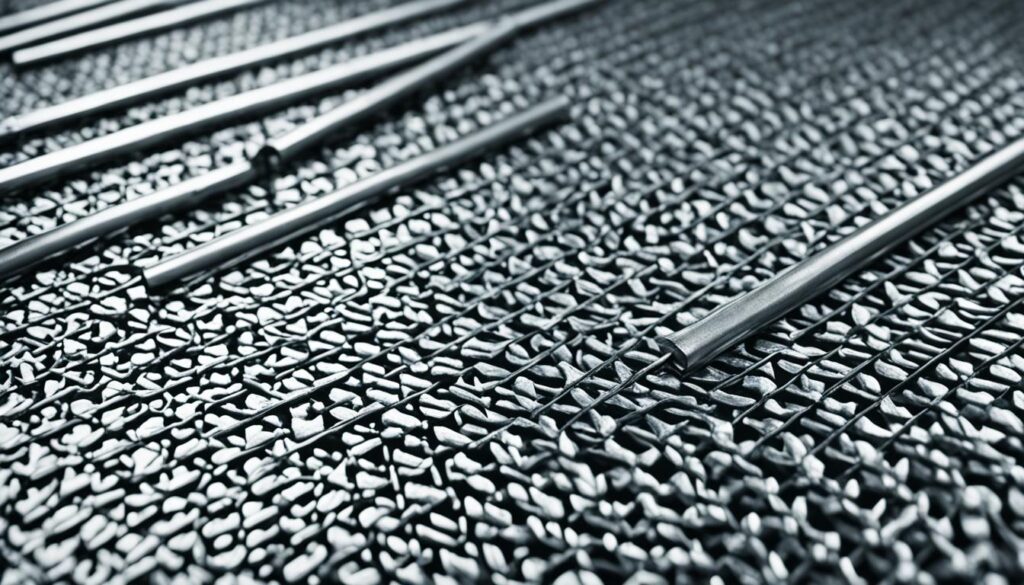
Wrought iron, often called rod iron, is known for its beautiful and detailed designs that get even more stunning with age12. While the terms wrought iron and rod iron might seem similar, knowing the real term shows how much we value items like patio furniture and home decor11. Even though wrought iron has its upkeep challenges, it’s still loved for its classic beauty and style10.
Wrought iron is used in many household items like gates, fences, and outdoor furniture, and even in indoor decorations like wall art and grills11. Its versatility makes it popular in ironmongery and metal work. Yet, wrought iron fences need regular care because they can rust and wear down over time10. Taking good care of them can help prevent rust and make them last longer12.
Let’s look at how “rod iron” is often misunderstood compared to real wrought iron fences:
| Aspect | Wrought Iron | Common “Rod Iron” Misconception |
|---|---|---|
| Terminology | Wrought Iron | Rod Iron |
| Material | Iron alloy with low carbon content | Often confused with wrought iron |
| Properties | Soft, ductile, elegant | Misunderstood as a different type of iron |
| Uses | Fencing, gates, furniture, décor | Often incorrectly referred to as fences |
Using the correct term wrought iron instead of “rod iron” respects its history and highlights its value in ironmongery and metal work. This clears up confusion, keeping this classic craft relevant and cherished today.
Comparing Cast Iron to Wrought Iron
Cast iron and wrought iron have different ways of being made, and they last and get used in different ways. Each has its own special uses because of how it’s made and what it’s like.
Production Differences
Cast iron is made by melting iron and pouring it into molds. This makes complex shapes and lets it be made on a big scale. It’s very hard and strong, perfect for things that need to hold up a lot of weight13.
Wrought iron is heated and shaped to get rid of slag and make the metal better. This makes it bendy and easy to shape14. It has a bit less carbon than cast iron, so it’s softer13.
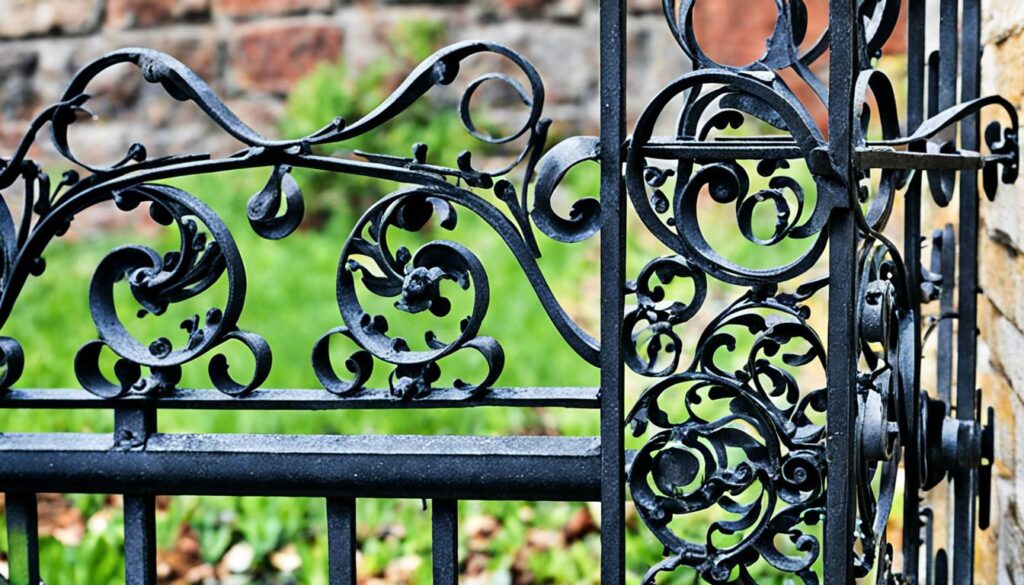
Durability and Strength
Wrought iron is very strong and doesn’t rust easily, making it great for outdoor and decorative items13. Cast iron is also very strong but can be brittle. It’s best for things that don’t need to stretch or bend much14.
Common Applications
Wrought iron is often used for things like gates, railings, and furniture because it can be shaped and looks nice13. Cast iron is great for making cookware, car parts, pipes, and machinery because it’s easy to cast and doesn’t cost much14.
Both materials have their own strengths: wrought iron is strong and doesn’t rust, and cast iron is great for heavy-duty use and can be shaped easily1413.
Conclusion
Exploring “Is it rod iron or wrought iron?” shows us why knowing about materials, history, and how they’re made is key. Wrought iron has less than 0.08% carbon. This makes it bendy and resistant to rust, unlike carbon steel and stainless steel15.
Wrought iron’s impact is still strong in blacksmithing and fixing old items. It’s great for making detailed designs because it’s easy to shape15. Making wrought iron is hard work but it’s worth it for its beauty and lasting quality15.
Today, it’s important to know the difference between wrought iron and other metals. This keeps the old craft alive and shows off wrought iron’s strength and flexibility16. As we keep making new things, wrought iron proves its value and the talent behind each piece.
FAQ
Is it rod iron or wrought iron?
What is wrought iron?
What is the historical significance of wrought iron?
How is wrought iron produced?
Why is there confusion between rod iron and wrought iron?
What is the correct terminology for worked iron?
What are the chemical properties of wrought iron?
What are the key applications of wrought iron?
What advantages does wrought iron offer in ornamental ironwork?
What are the production differences between cast iron and wrought iron?
How do durability and strength compare between cast iron and wrought iron?
What are common applications of cast iron and wrought iron?
Source Links
- How to Identify if It’s Wrought Iron | Universal Iron Doors – https://www.iwantthatdoor.com/how-to-identify-if-its-wrought-iron/
- Wrought iron – https://en.wikipedia.org/wiki/Wrought_iron
- What Is Rod Iron? – Irish Iron – https://irishiron.com/blog/what-is-rod-iron/
- Wrought iron | Properties, Uses & History – https://www.britannica.com/technology/wrought-iron
- Is it “rod iron”? Is it “rot iron”? Or is it “wrought iron”? – https://avionmetalworks.com/is-it-rod-iron-is-it-rot-iron-or-is-it-wrought-iron/
- Wrought Iron | Rod Iron or Rot Iron – https://wroughtworks.com/wrought-iron-rod-iron-or-rot-iron/
- Ornamental Iron vs Wrought Iron: What’s the Difference? – Tampa Steel & Supply – https://tampasteel.com/ornamental-iron-vs-wrought-iron/
- Wrought Iron: Characteristics, Uses and Problems – https://www.gsa.gov/real-estate/historic-preservation/historic-preservation-policy-tools/preservation-tools-resources/technical-procedures/wrought-iron-characteristics-uses-and-problems
- Iron VS Steel Click To Find Out More – thyssenkrupp Materials (UK) – https://www.thyssenkrupp-materials.co.uk/technical-knowledge-hub/iron-vs-steel
- Wrought Iron Fence – Everything You Need to Know – Northland Fence – https://www.northlandfence.com/wrought-iron-pros/
- Can I Recycle Wrought Iron? – https://www.gardencityironandmetal.com/blog/can-i-recycle-wrought-iron/
- Steel vs. Wrought Iron Fencing | AR Iron Gates and Fencing – https://arironllc.com/blog/steel-vs-wrought-iron-fencing/
- Wrought vs Cast Iron: What is The Difference? | Metal Supermarkets – https://www.metalsupermarkets.com/wrought-vs-cast-iron-what-is-the-difference/
- Industrial Metal Supply Company – https://www.industrialmetalsupply.com/blog/difference-between-cast-and-wrought-iron
- What’s the difference between wrought Iron vs steel? – Irish Iron – https://irishiron.com/blog/whats-the-difference-between-wrought-iron-and-metal-iron-or-steel/
- The Timeless Elegance of Wrought Iron Furniture – https://palmcasual.com/learn-about-the-timeless-elegance-of-wrought-iron-furniture/
